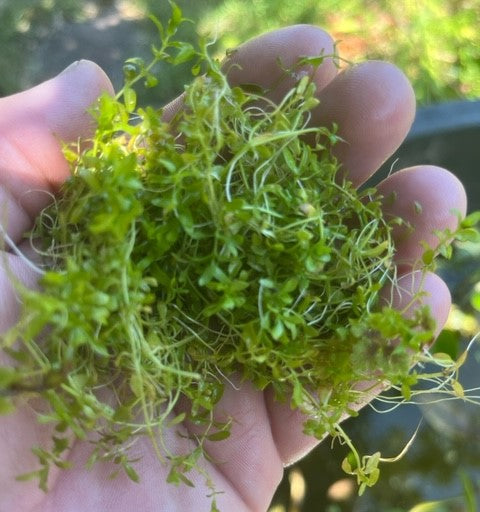In the pursuit of establishing a thriving and pest-resistant aquatic ecosystem, it is crucial to adopt proactive measures in the preparation and treatment of aquarium plants before their introduction to the tank. A well-executed pre-treatment process can effectively prevent potential snail infestations, pathogenic challenges, and the intrusion of other unwanted organisms, thus fostering a flourishing underwater environment. Within this guide, we will delve into an array of techniques that enable the safe and confident readiness of your plants for their new aquatic home.
Please Note: All treatment methods come with inherent risks. For this,KJE nor its associates can be held accountable for any damages resulting from the application of these methods. It is imperative to exercise prudence and carry out these techniques responsibly. All risks are assumed by the end user.
KJE Aquatics’ standpoint on snails is that they are not inherently detrimental and form a natural component of a healthy ecosystem. They can contribute more benefits than drawbacks to a tank if their population is naturally controlled – the key lies in avoiding overfeeding your fish.
- Aquarium Salt Solution
Introduction: Drawing inspiration from terrestrial practices, salt can play a pivotal role in eradicating snails and their eggs within an aquatic setting.
Procedure:
Solution Preparation: Create a solution by blending aquarium salt or kosher salt with dechlorinated water, maintaining a ratio of one cup of salt per gallon of water.
Dipping Process: Submerge the plants gently into the saltwater solution, allowing a brief exposure of 15-20 seconds while keeping the roots above the water.
Final Rinse: After the saltwater immersion, thoroughly rinse the plants in dechlorinated freshwater to ensure their purity before transplantation.
Key Considerations:
Salt Selection: Steer clear of table salt or iodized salt due to the potential presence of harmful additives.
Plant Sensitivity: To gauge sensitivity, conduct a trial on a single plant before treating your entire collection.
- Alum Immersion
Overview: Aluminum sulfate, commonly known as alum, offers a milder yet effective option for plant treatment.
Steps:
Solution Preparation: Dissolve 1-3 tablespoons of alum per gallon of warm water to craft the solution.
Plant Bath: Immerse the plants in the solution, adjusting the treatment duration from 2-3 hours for stronger solutions to up to 24 hours for gentler ones.
Egg Eradication: Alum targets snails, though its effectiveness against eggs may be slightly diminished.
Rinse and Relocation: Conclude the treatment by meticulously rinsing the plants in dechlorinated water before introducing them to the aquarium.
- Chlorine Bleach Method
Background: Ordinary chlorine bleach, devoid of additives, can serve as a potent treatment option for robust plants.
Procedure:
Solution Preparation: Prepare a solution by diluting bleach to a 5% concentration (1 part bleach to 19 parts water).
Plant Soak: Immerse delicate species for 2 minutes or hardier plants for 3 minutes in the bleach solution.
Thorough Rinse: Subsequently, immerse and diligently rinse the plants in dechlorinated water to ensure the elimination of residual bleach.
Odor Dissipation: If a bleach scent lingers, soak the plants in water mixed with a dechlorinator before the final rinse.
- Utilizing Potassium Permanganate
Insight: Potassium Permanganate, a robust oxidizer, is effective against parasites and bacterial infections.
Application:
Preparation: Mix Potassium Permanganate with warm water to form a dark pink solution.
Plant Soak: Immerse the plants for 10-20 minutes, followed by thorough rinsing in fresh dechlorinated water.
Precautionary Measures: Wear gloves, safeguard your workspace, and avoid mixing with substances containing formaldehyde or alcohols.
Rinsing: A comprehensive rinse and a dip in dechlorinated water neutralize the solution's effects.
- Hydrogen Peroxide Treatment
Introduction: Hydrogen peroxide is a potent agent against algae, parasites, and undesired organisms.
Process:
Solution Preparation: Combine 3% hydrogen peroxide with dechlorinated water in a 1:3 ratio.
Dipping Process: Immerse the plants in the solution for approximately 5 minutes, ensuring all plant parts are exposed.
Observation and Cleansing: Monitor plant reactions during the dip, then rinse meticulously in dechlorinated water to eliminate residual hydrogen peroxide.
Plant Transition: Allow treated plants to acclimate to your tank's water temperature before placing them in the aquarium.
Key Notes:
- Plant Sensitivity: Prior to treating the entire plant, test a small portion for sensitivity.
- Concentration Caution: Stick to 3% hydrogen peroxide to prevent damage.
- Vigilance: Monitor the plants throughout the treatment process.
Incorporating these treatment methods into your plant preparation regimen is essential for safeguarding your aquatic environment. Whether you choose salt, alum, chlorine bleach, potassium permanganate, or hydrogen peroxide, adhering to recommended guidelines is pivotal for the success of both your aquarium plants and their inhabitants. Always prioritize the health and equilibrium of your aquatic ecosystem.

